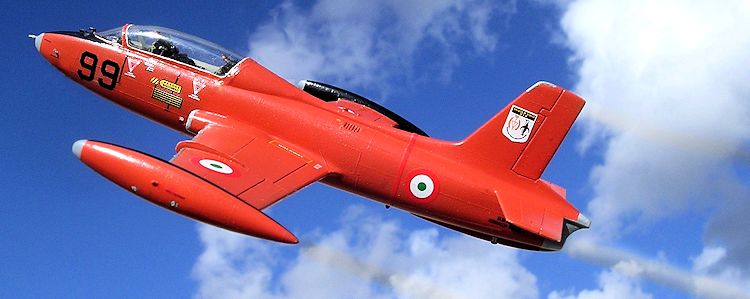
| KIT #: | 1308 |
| PRICE: | 12 Euros |
| DECALS: | Three options |
| REVIEWER: | Carmel J. Attard |
| NOTES: |

| HISTORY |
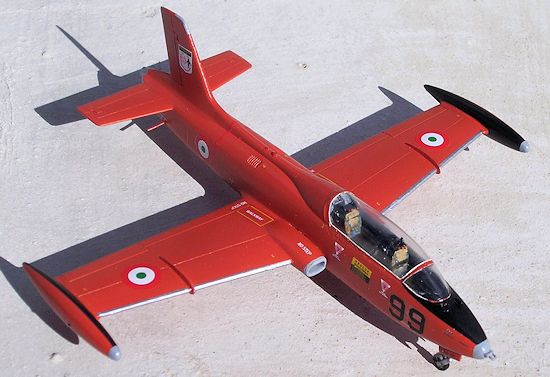 In an unbroken history dating back to the
period before WW1 Aeronautica Macchi has produced more than 7000 aircraft of its
own design. Approximately 10% of the total have been examples of the MB-326
family of jet trainers and light attack aircraft.
In an unbroken history dating back to the
period before WW1 Aeronautica Macchi has produced more than 7000 aircraft of its
own design. Approximately 10% of the total have been examples of the MB-326
family of jet trainers and light attack aircraft.
Dr.Ing. Ermanno Bazzochi who was Airmacchi’s
technical director and chief engineer began design work on the MB-326 as a
two-seat basic trainer during 1954 and the first two prototypes flew on 10th
December 1957. The aircraft was powered by one 1,750-lbst Bristol Siddeley
(later Rolls Royce) Viper 8 turbojet. The second prototype and the 15
pre-production aircraft ordered for the Aeronautica Militare Italiana (AMI) were
each powered by the first standard engine, the Viper ASV 11 turbojet at 2,500
lbst.
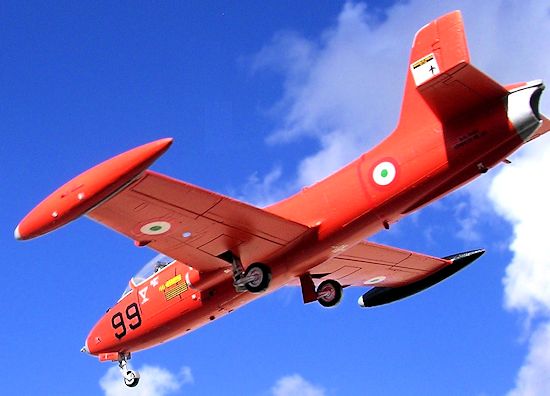
In 1981 the “Macchino” as the MB-326 was
nicknamed by the Italian pilots, was supplemented in the training role by
MB-339A and later operated in same liaison units up to 1994, when it was finally
withdrawn. During its service life the MB-326 visited places like Hal Luqa,
Malta and other airfields on the Italian mainland and was based in Ciampino,
Grazzanire, Decimomanno, Gioia del Colle, Pratica di Mare and Venegano.
| THE KIT |
This is the same model issued by Supermodel
back in 1990 of Italy with the main difference being in the revised decal sheet.
The kit is molded in pale grey styrene and comes with a reasonable cockpit
comprising crew seats, instrument panels for both crew, consoles and decals for
the instruments. The seats do not look quite the type to me being on the narrow
side but Pavla Models of the Czech
 Republic makes justice to the otherwise a
good kit by providing a complete replacement cockpit interior parts in resin and
a very clear vac form canopy. Some time ago Aeroclub also made metal seats for
the type but I go for recent Pavla issue which one finds among their wide range
of resin detail parts at this scale of 1/72.
Republic makes justice to the otherwise a
good kit by providing a complete replacement cockpit interior parts in resin and
a very clear vac form canopy. Some time ago Aeroclub also made metal seats for
the type but I go for recent Pavla issue which one finds among their wide range
of resin detail parts at this scale of 1/72.
The Italeri kit of the MB-326 comes with an
under fuselage air brake that can be mounted in the extended position. This if
fitted in this form would be preferably dealt with after the undercarriage is
fixed to ensure clearance from the ground. Antennas and stores are also in the
kit box but one needs to refer to photos of the particular type being built to
ensure the correct stores and aerials are put on if any. Surface detail is
raised rather than engraved making it difficult to restore if these are removed
with excessive wet and dry.
The kit has three decal options, namely a
R.Australian AF team “Roulettes” based at East Sale Air Base, Victoria; another
belonging to the Brazilian AF. Squadron “Centauro” Santa Maria Air Base circa
1998 and any from three squadrons serving with Aeronautica Militare Italiana
namely 609 Squadriglia at Grazzanise, 1990, 603 Squadriglia at Ghedi 1989 and
another of Scuola Vole (flying school) at Galatina.
| CONSTRUCTION |
In line with the release of the kit by Italeri,
Pavla Models, as mentioned earlier have released a resin detail kit C72-103
consisting of highly detailed instrument panel, ejection seats, cockpit coaming,
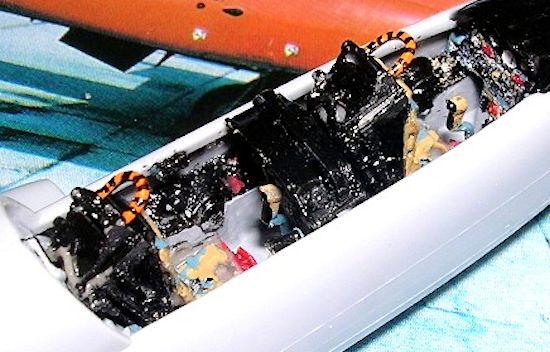 tiny side instruments items, correct ejection seats, canopy lifting device and
all these are with colour caption guides in both Czech and English language.
tiny side instruments items, correct ejection seats, canopy lifting device and
all these are with colour caption guides in both Czech and English language.
Construction starts with preparing the resin
parts to replace the less detailed kit ones of the Italeri model. These items
were painted accordingly and gently fitted in the forward part of the fuselage,
completing the cockpit in doing so.
Some lead weight was added in accordance to the kit instructions. The exhaust
pipe was added and the fuselage was closed. Assembly of the wings and tail
planes was a straightforward job. Fitting the undercarriage items, air brake
that I preferred to close, followed. Reference was made to the book Volume II
Jet. Venti Anni di Aeronautica Militare Italiana meaning (ghoxrin sena tal-qawwa
tal-ajru taljana) by Frans Storaro 1978-1999.
In this book there is the orange MB-326
picture on page 66 and 67 in same squadron markings that I chose to make mine.
These showed that the aircraft lacked the under fuselage long antenna as well as
the semi circle aerial fitted to the tail fin and so I have left these out.
Finally I cut and fitted the Pavla clear vac form canopy using Klear, after I
trimmed it to a perfect match at its location.
| COLORS & MARKINGS |
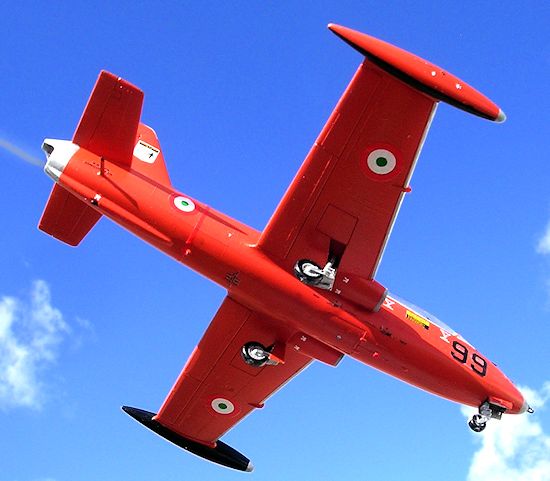 Model was finished in Compucolor International
Orange after first giving a spray base coat of Model Master insignia white. Then
after a coat of Klear I applied decal markings for machine No 99 Aeronautica
Militare Scuola Vuolo 61 Sturmo, Galatina (LE). Decal sheet also contained white
stencilling which were common to all the three different schemes for the Macchi
kit.
Model was finished in Compucolor International
Orange after first giving a spray base coat of Model Master insignia white. Then
after a coat of Klear I applied decal markings for machine No 99 Aeronautica
Militare Scuola Vuolo 61 Sturmo, Galatina (LE). Decal sheet also contained white
stencilling which were common to all the three different schemes for the Macchi
kit.
| CONCLUSIONS |
I quite enjoyed building the model and it
stands out every time I placed it next to a line-up of a Starfighter, Tornado
and a Typhoon all in Italian AF markings.
January 2013
If you would like your product reviewed fairly and fairly quickly, please contact the editor or see other details in the Note to Contributors.